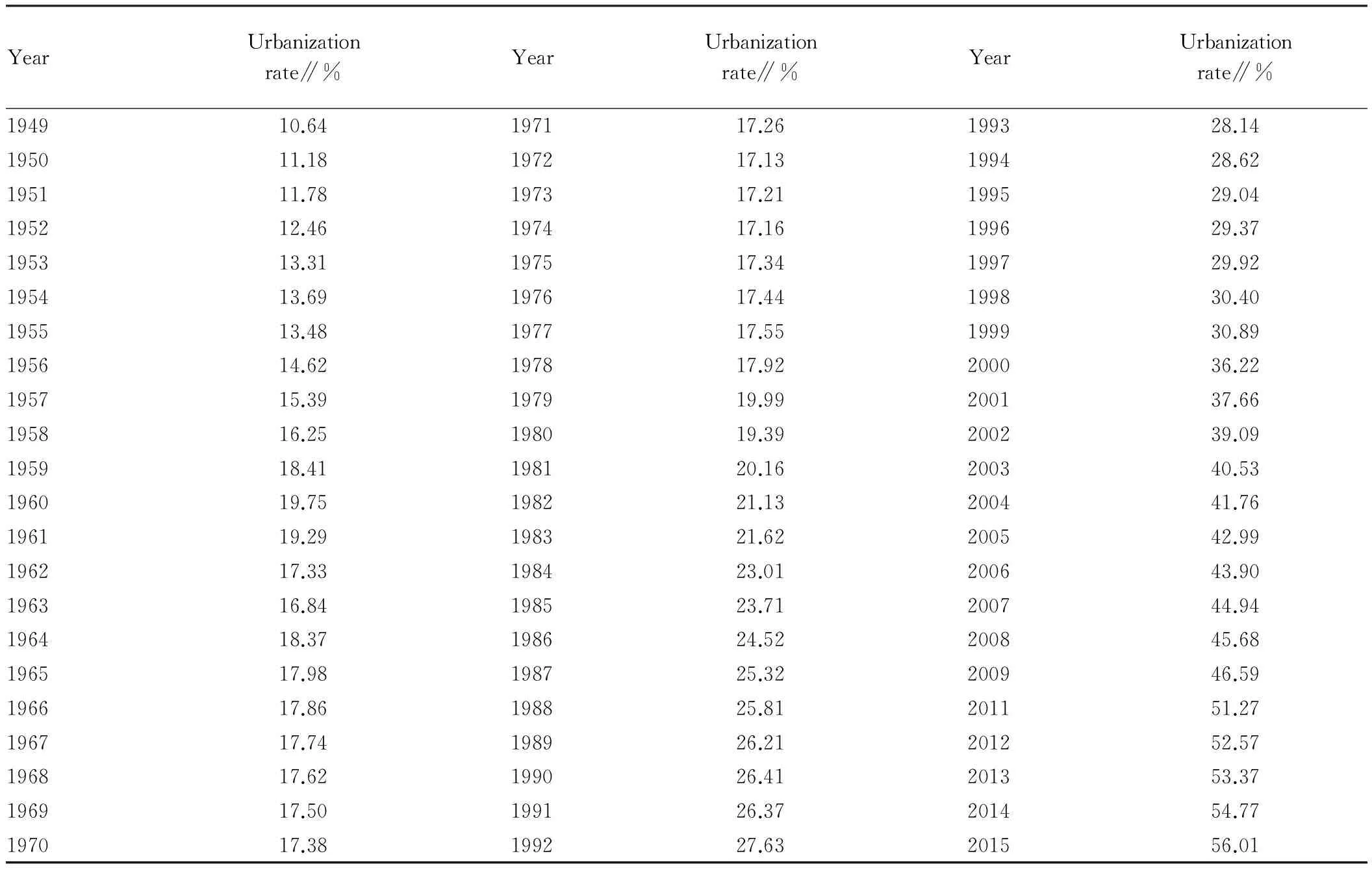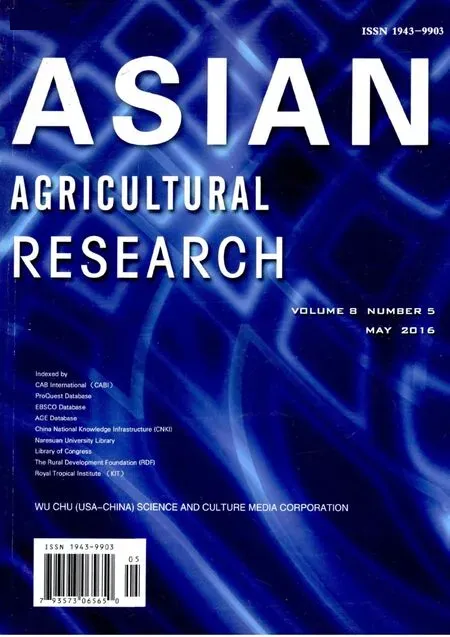On China’s New Urbanization and Land Use
, ,2*
1. College of Economics and Management, Anhui Agricultural University, Hefei 230036, China; 2. Institute of Land and Resources, Anhui Agricultural University, Hefei 230036, China
1 Introduction
As old sayings go, "bread is the stall of life", "no root, no fruit", "land is fundamental to state politics", people have long attached importance to land since ancient times[1]. After the founding of New China, China’s rural land shifted from the hand of farmers to collectives through cooperatives and mutual aid groups. Collective ownership of land was implemented in 1958 when the people’s communes were established, that is, land can be owned by the people’s communes, townships or production teams, but production teams dominated the ownership. The collectives were not only land owners, but also land users, and farmers recorded the labor time on collective land and shared bonuses at the end of year. The original intention of this land use system was good, and land can be organized to promote large scale operation. However, the productive forces were backward at the time, and there were no conditions to promote large-scale agricultural operation. Additionally, the unfairness of recording work points greatly eroded farmers’ enthusiasm for production. The Third Plenary Session of the Eleventh CPC was held in 1978, and the government decided to break the "big-pot" system of people’s commune and implement household contract responsibility system, thus arousing farmers’ enthusiasm for production, greatly emancipating productivity in rural areas, and continuously increasing China’s total grain output. Nevertheless, with the advance of modernization of agriculture, industry, national defense and science and technology, the biggest problem that we face is how to achieve coordination between economic development and farmland, ecological protection in promoting new urbanization process. Based on this, this paper makes some constructive discussions to provide a reference.
2 Overview of China’s urbanization development
2.1State-ownedurbanlandsystemreformSince 1949, China’s urbanization has gone through sixth stages: resumption of development; ups and downs; stagnation; revitalization; rapid development; new urbanization (Table 1)[1]. Table 1 shows that within seven decades, the urbanization level of China has risen from 10.64% to 56.01%. From 1949 to 1984, China’s urbanization rate increased from 10.64% to 23.01%; from 1985 to 1990, China’s urbanization rate increased from 23.01% to 26.41%; from 1991 to 2015, China’s urbanization rate increased from 26.41% to 56.01%. The figures show that China’s urbanization acceleration started from 1984, especially after 1990, indicating that the state-owned land use system reform is the most direct driving force to promote the development of urbanization. In 1984, Shenzhen City took the lead to transfer state-owned land use rights, breaking the imprisonment of free state-owned land use. In 1990, the State Council issuedProvisionalRegulationsonTransferofState-ownedUrbanLandUseRightsinPeople’sRepublicofChina, which clearly provided: "The state implements state-owned urban land use right transfer system in accordance with the principle of separation of ownership from use rights". From then on, China ended the indefinite, unpaid and stagnant state-owned urban land use system.
2.2CurrentsituationofurbanizationdevelopmentFirstly, as of 2015, China’s urbanization rate was 56.01%, an increase of 45.54 percentage points over 1949[2]. However, due to late start of China’s urbanization, combined with urban-biased policy, a large number of rural resources flow to urban areas, leading to a great difference between urban and rural areas. Secondly, there are huge differences in either natural resource endowments, or social and economic development. Therefore, there are huge differences in the level of urbanization between developed southeast coastal areas and underdeveloped western areas, even within the province. Thirdly, compared with developed countries, such as the United States, the gap is still very large. Fourthly, the urban development idea is still relatively backward, and urban sprawl model is still used.
3 Major problems in land use during urbanization
3.1InefficientuseandabandoningoffarmlandDue to low comparative benefit of agriculture, with the development of urbanization, most of rural migrant labor forces choose to work outside home, with women, children and the elderly left behind. In 2015, Anhui had a permanent population of 61.436 million, including 31.025 million population living in city and 30.411 million population living in countryside, and there were 69.491 million people with census register, including 50.3115 million people with rural registered permanent residence. The above figures show that Anhui’s permanent rural population in the city is 27.9555 million, there are a total of 18.588 million migrant workers, and there is an inter-provincial floating population of 8.055 million. The outflow of a large number of rural labor forces has led to extensive rural land use, and serious seasonal abandoning of high quality farmland.
Table1DynamicchangesinChina’surbanizationrate

YearUrbanizationrate∥%YearUrbanizationrate∥%YearUrbanizationrate∥%194910.64197117.26199328.14195011.18197217.13199428.62195111.78197317.21199529.04195212.46197417.16199629.37195313.31197517.34199729.92195413.69197617.44199830.40195513.48197717.55199930.89195614.62197817.92200036.22195715.39197919.99200137.66195816.25198019.39200239.09195918.41198120.16200340.53196019.75198221.13200441.76196119.29198321.62200542.99196217.33198423.01200643.90196316.84198523.71200744.94196418.37198624.52200845.68196517.98198725.32200946.59196617.86198825.81201151.27196717.74198926.21201252.57196817.62199026.41201353.37196917.50199126.37201454.77197017.38199227.63201556.01
3.2InefficientlanduseandabandoningwithinthecityAffected by land finance, the city government is keen to increase amount of land by land acquisition, and it is not good at tapping the potential of land. For example, the service life of industrial land is 50 years, but the life of many industrial projects is only 7-8 years, thus resulting in the inefficient use and even abandoning of urban land, especially industrial land. According to the research, the inefficiently used land or abandoned land within city accounts for about one third of total urban area.
3.3ObviouslandecologicalproblemsThe primary problem is farmland pollution. The second land survey data show that the area of seriously polluted farmland reaches about 3333333.3 ha. The second problem is farmland degradation. The process of urbanization is bound to occupy farmland, but in promoting balance between farmland occupying and compensation, we often emphasize quantity balance but neglect quality balance, resulting in decreased quality of farmland. According to the survey, before implementation of quality and quantity level conversion of supplementary land, the quality of supplementary farmland decreases by 3 times compared with the farmland occupied in some areas, especially mountainous areas.
4 Recommendations
4.1PromotingthenewurbanizationcenteredaroundfarmercitizenizationandstrengtheningthetransferofagriculturallandIt is necessary to promote rural land transfer and implement moderate scale operation. The development of modern agriculture is an effective way to solve inefficient rural land use and abandoning. We must enable the farmers in the city to enjoy their rights to education, employment, medical and old-age care, and housing, so that they can voluntarily release the land management rights in the hands. Otherwise, they would rather inefficiently use or abandon farmland than give up the contracted farmland. At the same time, it is necessary to formulate policies, including land policy, subsidy policy, credit policy and tax policy, to support the
development of new agricultural business entities, and encourage them to absorb land, in order to achieve the moderate scale operation.
4.2DevelopingandimplementingurbanconstructionlandreductionplanandcontrollingconstructionlandincrementfromthesupplysideUnder the pressure of ecological red line and farmland red line, it is necessary to encourage city governments to develop and implement construction land reduction plan to gradually decrease the supply of new land for construction and increase the renewed urban land, thereby achieving the decline in overall scale and growth rate of construction land. In calculating the incremental land price, we should increase the land investment income compensation and ecological function loss compensation after land transfer, and use the economic leverage to force land users to tap land potential, which can not only reduce construction land consumption, but also enhance the urbanization quality and farmland protection.
4.3ImplementinglanduseandecologicalcoordinationprojectFirstly, it is necessary to strengthen urban sewage treatment, enhance the construction of wetlands around lakes and rivers, and use wetland filtering to improve water quality so as to greatly improve the sewage treatment effect. Secondly, it is necessary to strengthen agricultural nonpoint source pollution control, including control of soil erosion, establishment of agricultural technical extension team in line with China’s rural reality and implementation of agricultural fertilizer reduction growth plan. Thirdly, it is necessary to change the existing land remediation concept, and promote the land remediation mode centered around ecological priority and green development in accordance with local conditions.
[1] YU ZX, LI DT.Study on the utilization and protection of cultivated land under the background of new-pattern urbanization[J].Journal of Anhui Agricultural University(Social Science Edition),2016,3(2):1-7.(in Chinese).
[2] YU ZX. On promoting the citizenization of migration rural population using land security policy[J]. Jianghuai Tribune, 2015(3):34-35.(in Chinese).
 Asian Agricultural Research2016年5期
Asian Agricultural Research2016年5期
- Asian Agricultural Research的其它文章
- Research on Compensation Mechanism of Land Acquisition in Rural Areas Based on the Practice of Anhui Province
- Methods and Paths for Rural Collectively Owned Profit-oriented Construction Land Entering into Trading Market
- Effect of Transplantation in Different Seedling Age on Growth and Yield of Spring Maize in Shanxi Early Mature Area
- Effect of Nitrogen Topdressing on Growth and Yield of Garlic
- A Study on Phosphorus Use Efficiency of Wheat
- Quantity Calculation of the Land Unsuitable for Farming: A Case Study of Anze County in Shanxi Province
